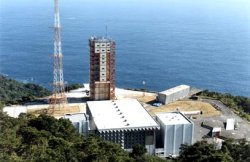Uchinoura Space Center

Uchinoura Space Center, M-series launch facility.
Uchinoura Space Center is one of Japan's two main rocket launch sites. Formerly known as Kagoshima
Space Center when it was operated by ISAS (Institute
of Space and Aeronautical Science), the name was changed to Uchinoura Space
Center (USC) when JAXA (Japan Aerospace Exploration
Agency) was formed. About two dozen satellites and their M
series launch vehicles (including the latest M-5) and more than 300
sounding rockets have been launched from here. USC also has optical observation
posts and a 20-meter and a 34-meter antenna for satellite telemetry receiving,
tracking, and control; in addition, the 34-meter dish can be used to back
up the 64-meter deep-space antenna at the Usuda Deep Space Center. Whereas Tanegashima Space Center launches satellites
for weather, broadcasting, and communications, USC's main launches are for
scientific purposes, such as astronomical observation and planetary exploration.
USC covers an area of 71 hectares, mostly hilly; its main facilities sit
on the top of flattened hills and are connected by roads.
USC was established in Uchinoura (now Kimotsuki) on the east of Ohsumi Peninsula, Kagoshima prefecture, in February 1962 as part of ISAS, University of Tokyo, when the original facility in Iwaki (now Yuri-Honjo), Akita prefecture, was closed down. In 1964, the space center became part of ISAS; in 1981 it became an independent research facility – the Kagoshima Space Center (KSC) – attached to ISAS. It was given its present name on 1 October 2003.


